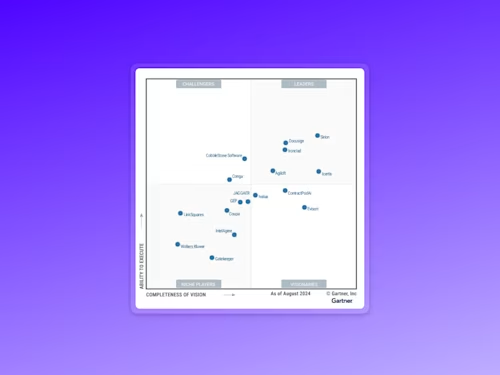
Exceptional Employee Experiences Lead to Customer Success
We know that customer success can be accelerated by people-focused leadership. Here are 3 insights about what drives rewarding customer experiences.
Table of contents

Over the last couple of years we have seen businesses face immense challenges which has encouraged us all to rethink and dramatically change how we operate. So many parts of our lives have been upended, and so quickly, that it's brought into stark reality exactly what's essential, and what's not.
The common thread through this all—challenge and change alike—is humanity. In our professional and personal lives, we're all consumers, searching for great experiences that keep us coming back for more. And now more than ever, consumers hold the power, with an ever-expanding menu of options. One bad experience and you've lost them.
We know that customer success is business success and this can be accelerated by people-focused leadership. The word "people" encompasses everyone and that includes employees. A great customer experience starts with a great employee experience.
Here are three insights about what really drives rewarding customer experiences.
#1 Great leadership
It's critical that leaders take personal responsibility for building and nurturing a customer-focused culture, and fully supporting their employees in service of that goal.
According to a recent Forrester survey however, only 44% of employees believe their leaders hold themselves accountable for exceptional customer experiences. Clearly there is ample room for improvement here. Even if leaders are setting a customer-focused tone, it's clearly not translating well to the rest of the organisation—including those most often interacting with customers.
Just telling your employees that you're going to focus on ensuring fantastic customer experiences isn't going to work. Repeating the words "customer first" in all your emails and Zoom calls isn't enough.
Actions create change, not words. When leaders embrace—and model—a customer-first mentality, it cascades through the organisation, positively impacting everything from hiring similarly customer-focused people to dedicating budget to employee training, resources and recognition.
The Forrester research is crystal clear here: 89% of respondents in the most customer-focused organisations felt they had the tools, technologies and information they needed to succeed.
The list of these change-making actions is long, and maybe you can't do everything right away. But start small and make your intentions clear: You're listening and responding to your employees' needs.
Think about things like giving them the space they need to be creative. Fostering a nimble environment that allows for quick adaptation to changing customer needs and circumstances. Measuring their experiences and then acting on the results. Automating manual processes and removing roadblocks. And supporting their health and wellness—both physical and mental.
If you're customer-focused, you're probably already doing a lot of these things for your customers. The point here is to replicate that same intent and laser focus—and create great experiences for your employees.
#2 Budgets and behaviours
All the methods mentioned so far around improving employee and customer experience certainly take dedication and leadership. But without budget, they can be hard to achieve.
One approach is to position customer experience as part of every employee's role, not just those who interface with customers, or have customer success in their titles. Every interaction a customer has with your brand should be positive and memorable. That's why it's so important for leaders to frame each department's mission—whether finance, sales, design, digital, or support—as having a direct impact on customer success.
Creating these memorable moments keeps customers happy and helps prove that customer success is a real business driver, justifying further investment internally.
Yet, sometimes the budget just isn't there, so search for those opportunities where momentum can be made in small, incremental steps, and at a lower cost.
Data is key here. Did those small changes lead to a better employee experience? Did that in turn lead to a better customer experience? Given the myriad ways now available to gather and measure data, it's easier than ever to show a return on these initiatives, which should lead to further investment. It might even be true that your existing efforts are already having an impact, but the data just hasn't been analysed in a way that shows it.
No matter how you slice the data to prove the business benefits, one through-line must remain: Every change you make must improve the employee and customer experience in a measurable way.
If anyone in the decision chain is having a hard time grasping that, it's time to preach the power of empathy. Have leaders spend time learning and experiencing the day-to-day realities of their employees who interact with customers. Have them talk with customers to get an intimate understanding of their challenges and needs. Employees and customers aren't just lines on a spreadsheet or numbers expressed in a bottom line. They're all people searching for simplicity and success.
#3 Moving forward
Growing and reinforcing a customer-focused culture starts with people-focused leaders. Equipping your employees with the right resources—empowerment, automation, tools and budget—will help them create rewarding customer experiences while thriving in their careers. Done right, it's a virtuous circle. Altruism pays off in the near term by enriching the lives of everyone associated with your business, and in the long term by improving your bottom line.
In today's digital age, it's crucial to streamline business processes and provide intuitive experiences for both employees and customers. By leveraging modern tools and technologies, you can create a more efficient and customer-centric organization.
[1] Forrester, "The Customer-Obsessed Leader, 2021
Related posts
 Insights for LeadersUpdated 11 Feb 2025
Insights for LeadersUpdated 11 Feb 2025

8 Contract Management Trends to Watch in 2025
Discover what's new with Docusign IAM or start with eSignature for free


